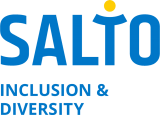Digital inclusion: a matter of policies?
Article
The first official recommendations document directly regarding digital youth work, or the wider and encompassing category of smart youth work, is quite recent, having resulted from the EC Expert Group activities on Digitalisation and Youth, set under the EU work plan for youth in 2016-2018:
The Council adopted these resolutions (2019/C 414/02) and made this document even more relevant.
After a few years, and after the huge boost that digitalisation had during the covid pandemic, some of the content of this publication will need some updating, to include and capitalise on all the learning we had during the lockdown months.
However, there is still a lot of very useful resources and content in this publication, starting with the working definition of digital youth work, which noted down officially for the very first time what we mean when we use this expression:
● Digital youth work means proactively using or addressing digital media and technology in youth work.
● Digital youth work is not a youth-work method – digital youth work can be included in any youth-work setting (open youth work, youth information and counselling, youth clubs, detached youth work…).
● Digital youth work has the same goals as youth work in general, and using digital media and technology in youth work should always support these goals.
● Digital youth work can happen in face-to-face situations as well as in online environments – or in a mixture of these two. Digital media and technology can be used either as a tool, an activity or as content in youth work.
● Digital youth work is underpinned by the same ethics, values and principles as youth work.
● Youth workers in this context refer to both paid and volunteer youth workers.
In light of this definition, the experience we had during the covid pandemic was one specific application of digital youth work, limited to online environments, but there are many other possible applications and we should consider a wider, more blended approach, which should be further explored.
A dedicated Strategic National Agencies Cooperation project (SNAC) on digital youth work is now developing a more detailed set of recommendations, practices, examples that could be implemented in the new European programme for youth following Erasmus +, working in accordance with the Work Plan for the EU Youth Strategy 2019–2021, and within the wider framework of the Digital Education Action Plan.
Regarding the new European programme, the covid situation affected it too, and as we write, official information is still to come; we should particularly remember that the three main priorities of the new programme will be Digital, Green and Inclusion;
we know that the programme will give special attention to the digital dimension and support digital and smart youth work, support digital media and learning that complements physical learning mobility, and support the development of digital skills and competences, media literacy and digital forms of youth participation; this will probably mean increased attention on what should be called a blended approach, where online and offline activities are offered together as parts of a learning path that is able to cover all the different dimensions.
It might be challenging for youth workers to reconcile the three aspects when designing and implementing a project, but we believe it can be done, and either in chapter 4, talking about the design of the activities, or in the podcast related to chapter 2, talking about digitalisation and inclusion, we have offered some hints and examples of what is already happening in this field.
Since we are discussing policies, we should underline that inclusive digital activities need to be tailored to meet participants’ needs and situations, and this calls for an extended and trained knowledge of the digital dimension of youth work, in order to fully take advantage of what the new European programmes will be offering, and to meet the programmes’ priorities. But in many cases, youth work still lacks full official recognition, not to mention national resources for training, updating skills etc.
As the last European Youth Work Convention stated in the final declaration,
“youth work should continue to be embedded in both long-term youth specific strategies and their intermediary measures”
and we would need to
“have a youth work research agenda focusing on participatory action research, carried out in co-operation between research and practice, and creating a knowledge base relevant to practice, policy and education”,
with
“national working groups, representative of the youth work community of practice, that could function as connection points, knowledge hubs and coordinators of all the different measures needed to develop quality”.
The same document clearly calls for innovative youth work in these directions, perfectly in line with the new programme’s priorities:
“improving smart youth work while putting greater focus on developing the digital competences of young people and youth workers, investing in technological infrastructure and innovation which will help overcome the digital divide and ensuring access to youth work for all young people; making youth work greener. Encourage and prioritise practices and solutions that are environmentally friendly, aligned with the principles of sustainable development, which youth work seeks to instill and young people expect”.
This is why we should always consider the digital divide when designing activities in online environments.
Being all connected together in a plenary online room, in a grid of little boxes showing our faces, is not the only way to be part of an online activity, and surely not one of the most inclusive ways.
Our work during the coming years and the next programme will be to connect this vision with the existing plans and recommendations, starting with the Expert Group publication, starting with the central role of training youth workers how to use digital environments and tools, and the development of the digital dimension of their competences, which is discussed in another chapter of our website.
In general, it is important to work strategically on something that will stay with us, retaining a relevant presence and impact from now on. These are the recommendations regarding a possible strategic development of digital youth work, proposed by the Expert Group, and they are still fully relevant:
● Every Member State should have a plan for developing and resourcing digital youth work as an integral part of their youth policy. Young people and youth organisations should be consulted and engaged in the development and implementation of this plan.
● Every Member State should provide strategic financial investment in digital youth work. Resources should be allocated to youth worker training, development of innovative digital youth work methodology, working time, infrastructure, and devices/technologies to be used with young people.
● Digital youth work should be incorporated into youth worker training, national youth work occupational standards and youth worker competence standards.
● Digitalisation and young people’s digital cultures should be taken into account
Discussing inclusion and digital youth work policies and recommendations, there are at least two levels where the bigger picture should be taken into account, when trying to figure out how to design more inclusive online activities.
We need to discuss several aspects connected with general infrastructural policies: be it the connectivity infrastructure and its accessibility, be it the possibility of having access to devices, and even the neglected right to repair them in order to reuse technologies, thus reducing the environmental impact that technology itself has. We are in need of new and more up-to-date regulations, to help us tackle all this.
The lockdown which occurred in many European Countries during the pandemic gave a great boost to the digitalisation of many aspects of our lives: work, leisure, school and, of course, even youth work – but it also made clear that many countries still lack proper broadband coverage, capable of reaching every area, including the most peripheral ones.
If youth work could only advocate for such measures, it could be directly involved in spreading knowledge about devices, how to fix them, repair them, expand their life and decrease their environmental footprint. The makers attitude, born inside the hacker cultures and slowly entering some youth centres and youth work projects, could be a strategy to enable more people, and more youngsters in particular, gain access to online environments and reduce the footprint of their digital activities, thus meeting the new programme’s priority of green youth work.
Here we should also refer to the wider topic of how the platforms we use, are using us indeed. It is becoming more and more evident that even if GDPR has been a landmark ruling in shaping how user data should be preserved and managed, there is still a lot to be done, especially dealing with social media and community-making platforms and apps, which are the parts of the Internet most used by youngsters nowadays. This is worthy of being tackled by the digital and blended activities which we should develop in the new programme, and it would meet the new programme’s digital priority, as well as being a strong need for European citizens of all ages.
The idea of creating European or national platforms for digital youth work could be a possible way of providing safe, accessible and inclusive public environments online in the same way they should be provided offline, but honestly youth work would not need yet-another-platform if it was not able to really offer up-to-date services and features.
If yes, then it would be very relevant should this platform be built taking into account all the most advanced ways of opening up technology to the needs and rights of user communities: open source software solutions, public APIs, open data formats, would be a way of setting the trend for possible future online environments operating more as a safe public space for youth, and less as a private system exploiting user data to stay alive.
About the author

Michele Di Paola
You can find me hangin' out at the crossing of liberal arts and digital technologies. That's my spot, where I enjoy working, learning and having fun using all kinds of human experiences.


